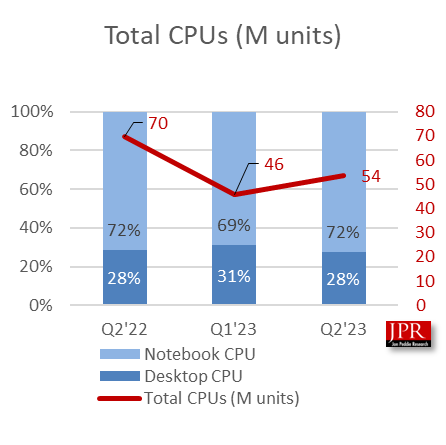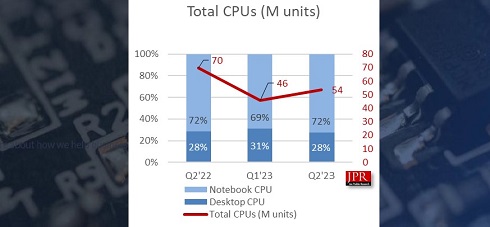Jon Peddie Research reports the growth of the global PC client-based CPU units market reached 53.6 million units in Q2’23, up 17%, and iGPU shipments increased by 14% to 49 million units.
Year over year, iGPUs declined -29%.`

Figure 1. Quarterly shipments of desktop and notebook CPUs
Integrated GPUs will have a compound annual growth rate of 2.5% during 2022–2026 and reach an installed base of 4.8 billion units at the end of the forecast period. Over the next five years, the penetration of iGPUs in the PC will grow to reach a level of 98%.
Year to year, total CPU shipments, which include all platforms and all types of CPUs (with and without graphics), decreased by -23%, desktop CPUs decreased by -25%, and notebooks decreased by -22%.
AMD’s overall client CPU market share percentage from last quarter decreased -5.3%, while Intel’s market share increased by 23%.
Jon Peddie, president of JPR, noted, “Q2’s increase in client CPU shipments from last quarter is positive and welcomed news in what has been depressing results for that quarter as well as for the last two years. Integrated graphics also increased from last quarter, which is not too remarkable given most CPUs have built-in GPUs. The forecast for next quarter is a cautionary positive. AMD and Intel are guiding upward, albeit modestly.
JPR’s Market Watch is available in electronic and hard-copy editions, and a single issue sells for $3,000. This report includes an Excel workbook with the data used to create the charts, the charts themselves, and supplemental information. The annual subscription price for JPR’s Market Watch is $6,000 and includes four quarterly issues. Full subscribers to JPR services receive TechWatch (the company’s exclusive access to daily news).
Click here to view the executive summary, table of contents, and more about this significant report or to download it now. For more information, call (415) 435-9368 or visit the Jon Peddie Research website at www.jonpeddie.com.
Contact Robert Dow at JPR (Robert@jonpeddie.com) for a free sample of TechWatch.
About Jon Peddie Research
Jon Peddie Research has been active in the graphics and multimedia fields for more than 30 years. JPR is a technically oriented multimedia and graphics research and consulting firm. Based in Tiburon, California, JPR provides consulting, research, and other specialized services to technology companies in various fields, including graphics development, multimedia for professional applications and consumer electronics, high-end computing, and Internet-access product development. JPR’s Market Watch is a quarterly report focused on PC graphics controllers’ market activity for notebook and desktop computing.

Company Contact:
Jon Peddie, Jon Peddie Research
(415) 435-9368
jon@jonpeddie.com
Robert Dow, Jon Peddie Research
(415) 435-9368
robert@jonpeddie.com
Media Contact
Carol Warren, Creor Group
(714) 890-4500
carol@creorgroup.com
Year over year, iGPUs declined -29%.`

Figure 1. Quarterly shipments of desktop and notebook CPUs
Integrated GPUs will have a compound annual growth rate of 2.5% during 2022–2026 and reach an installed base of 4.8 billion units at the end of the forecast period. Over the next five years, the penetration of iGPUs in the PC will grow to reach a level of 98%.
Year to year, total CPU shipments, which include all platforms and all types of CPUs (with and without graphics), decreased by -23%, desktop CPUs decreased by -25%, and notebooks decreased by -22%.
AMD’s overall client CPU market share percentage from last quarter decreased -5.3%, while Intel’s market share increased by 23%.
Jon Peddie, president of JPR, noted, “Q2’s increase in client CPU shipments from last quarter is positive and welcomed news in what has been depressing results for that quarter as well as for the last two years. Integrated graphics also increased from last quarter, which is not too remarkable given most CPUs have built-in GPUs. The forecast for next quarter is a cautionary positive. AMD and Intel are guiding upward, albeit modestly.
JPR’s Market Watch is available in electronic and hard-copy editions, and a single issue sells for $3,000. This report includes an Excel workbook with the data used to create the charts, the charts themselves, and supplemental information. The annual subscription price for JPR’s Market Watch is $6,000 and includes four quarterly issues. Full subscribers to JPR services receive TechWatch (the company’s exclusive access to daily news).
Click here to view the executive summary, table of contents, and more about this significant report or to download it now. For more information, call (415) 435-9368 or visit the Jon Peddie Research website at www.jonpeddie.com.
Contact Robert Dow at JPR (Robert@jonpeddie.com) for a free sample of TechWatch.
About Jon Peddie Research
Jon Peddie Research has been active in the graphics and multimedia fields for more than 30 years. JPR is a technically oriented multimedia and graphics research and consulting firm. Based in Tiburon, California, JPR provides consulting, research, and other specialized services to technology companies in various fields, including graphics development, multimedia for professional applications and consumer electronics, high-end computing, and Internet-access product development. JPR’s Market Watch is a quarterly report focused on PC graphics controllers’ market activity for notebook and desktop computing.

Company Contact:
Jon Peddie, Jon Peddie Research
(415) 435-9368
jon@jonpeddie.com
Robert Dow, Jon Peddie Research
(415) 435-9368
robert@jonpeddie.com
Media Contact
Carol Warren, Creor Group
(714) 890-4500
carol@creorgroup.com
